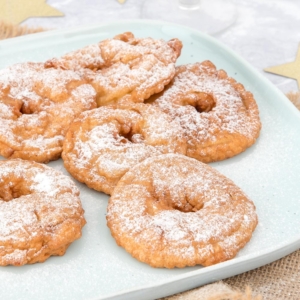Baking soda and baking powder
The difference between baking soda and baking powder
Baking soda and baking powder are both baking ingredients and have leavening power. But there is an important difference. In a nutshell:
Baking soda only works if you also add something acidic and some liquid or wet ingredient. Upon contact the baking soda will produce carbon dioxide gas which results in the leavening effect. When you’re using baking soda the effect will be immediate which means it is best to bake right away if you use baking soda.
Baking powder consists of baking soda and an acidic component (often cream of tartar), so no extra acid is needed and it works by itself. The reaction of baking powder works in two stages; the first reaction will be upon contact with the liquid. The second reaction will be upon heating in the oven.
Flavor
When not using enough acid in a baking recipe baking soda can have a soapy taste, so the acidic ingredient is needed to neutralize the flavor.
Baking powder already has a neutral taste since it has its own acid.
Shelf life
Baking soda lasts a really long time when stored in a dry place.
Baking powder does have an expiration date and a shorter shelf life due to the combined ingredients. You can test if it is still fresh by adding some warm water. If it creates air bubbles it is still active.
Substituting baking powder and baking soda
Can you use baking powder as a baking soda substitute and vice versa? Well technically no. Both work different and you cannot substitute one for the other. If you have only baking powder and the recipe wants you to use baking soda, you need about 3 times the amount of baking powder. But that will also have an effect on the texture of the cake batter as you will have more acid and extra filling.
If substituting baking powder with baking soda you will need an acidic ingredient to activate the baking soda. Which in turn will create a different flavor to the original intended recipe.
Combining baking soda and baking powder
If you use only baking soda in a recipe without an acid, it will have no effect. If you add baking powder, it will work because it already contains the dry acid you need. Of course, you can also use baking powder alone, but then you will need proportionally much more as the baking soda is only a small part of the mix.
For a nice, airy result, baking powder and baking soda are often combined. It will have a double acting effect. Even if the recipe already has the necessary acidity, it will still have a fluffy texture.
Baking soda reacts with these ingredients
Finally, the acidity I keep talking about. By now you’ve probably realized that baking soda needs enough acid to act as a leavening agent. Lemon is obvious, vinegar and buttermilk are also common and probably easy to think of.
But there are also ingredients that are less obvious. Honey, for example, but also chocolate or cocoa powder. Or what about sour cream ? There are many more ingredients than you might think that make baking soda work as a leavening agent. Check the list below for some surprising ingredients:
- Yogurt
- Sour cream
- maple syrup
- honey
- chocolate
- lemon juice
- grape juice
- brown sugar
- buttermilk
- vinegar
- orange juice
- ketchup
I bet there are a couple of ingredients here that you didn’t see coming. But this little list is not all. There are many more ingredients that will have the desired effect. Think about fruit purees for instance.
Did you know all this about baking soda? Or do you have more facts to share?















































